BMW Connected Drive as a trend
I, as well as any person from the IT sphere who is fond of cars, was always amazed at how slowly technology comes to cars. No, I’m not talking about parking radars, active safety systems and some modern light sources. I'm talking about entertainment technology. Remember how many years have passed since the advent of iPods to the time when the onboard systems began to support them? USB data carriers, SD cards, Bluetooth, Wi-FI, LTE — all of this didn’t appear in the machines at all at once, and first of all got into the models of the most expensive segment.
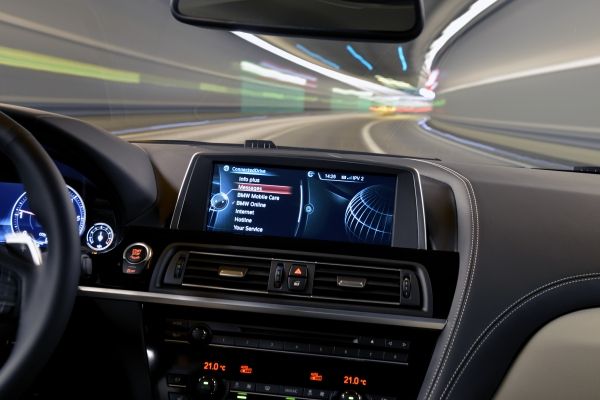
But not so long ago, the situation began to change. European manufacturers first developed their own control systems for the on-board computer and multimedia functions (Command from Mercedes-Benz, MMI from Audi, iDrive from BMW, OnCall from Volvo, etc.). Then they unified these systems throughout the model range. And then they began to "socialize" through the Internet. Of course, this will not accelerate the subsequent introduction of networks of 5-6 generations in cars or USB 4.0 and Bluetooth 5.1, when they appear. However, this will certainly reduce the gap in the software between mobile and automotive systems.
')
In general, the idea of a test drive with Connected Drive started with what I saw on the BMW website this picture:
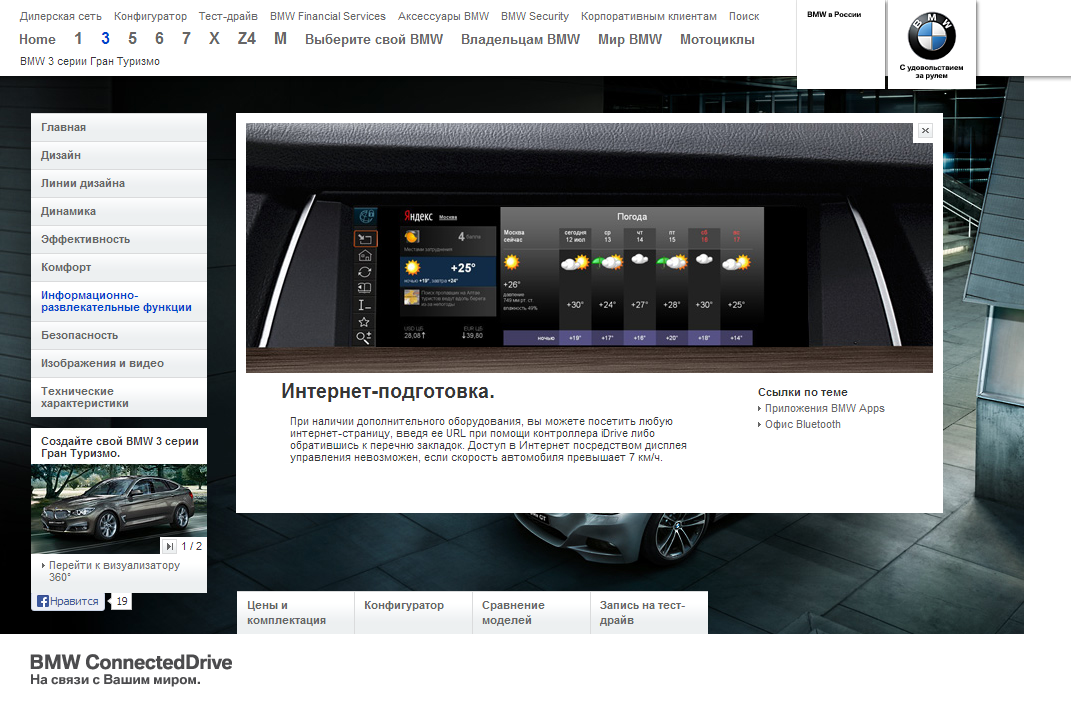
I once heard the story that Yandex made special Yandex cards for BMW, but it was a long time ago and at the level of rumors. And here is a screenshot of the car screen right in the description of the new 3GT model. Having seen it, I tried to find more information about what Connected Drive is and came across a large overview of its capabilities on the website motor.ru .
I confess that I did not particularly read the article. I ran over it with my eyes, saw some key facts and decided to find out whether it was possible to get a car with Connected Drive in Moscow for a test for at least a few days in order to describe my view on this system with the eyes of a person from the IT sphere. Just a few days later, I was given a BMW 640 Coupe for review and, to be honest, for the first couple of days I completely forgot about the original purpose of the test drive. Even to the careful words of an employee of the BMW Group Russia, who gave me a car, that while not everything works, that the first cars with built-in sim cards will appear in Russia towards the end of the year, that even in Germany the system is not fully deployed, I did not add attention. As a result, the very first attempt to get acquainted with the system closer turned out to be a failure. It turned out that my HTC 8X is nothing but a phone for this car. He did not even turn out to be a source of music for her via Bluetooth, which seemed quite strange.
When I found out that the music from the phone could not be listened to, I inserted a USB flash drive into the USB connector and was pleasantly surprised. Connected Drive is a rare case when the car doesn't need an iPod at all - you can listen to music by genres, albums, artists and playlists from any carrier. I lacked this chip in many car multimedia systems with USB connectors. Well, the optional sound from Bang & Olufsen is so good that you don’t want to listen to the radio on it - there’s too much of a lack of quality.
Standing in traffic jams with music is, of course, better than in silence, but with the Internet it would be even more fun. Therefore, when a colleague with an iPhone appeared on the passenger seat, we began to deal with the Connected Drive further. The phone was connected via Bluetooth and, unlike Windows Phone, it became available as an audio source. Already better, but the Internet is still unavailable. After several unsuccessful attempts to use a browser or download an application, we came across a system prompt stating that for full use we need to connect the phone via wire, and not via the wireless interface.
Okay, they pulled out a USB flash drive with music, plugged a cable into the USB connector, but that was not enough. To make it work you need to install a special BMW Connected application. It weighs more than 20 megabytes, so with the Moscow mobile Internet it is better to do it at home with Wi-Fi, rather than standing in traffic. Waiting for the installation, we finally saw the BMW Apps in work.
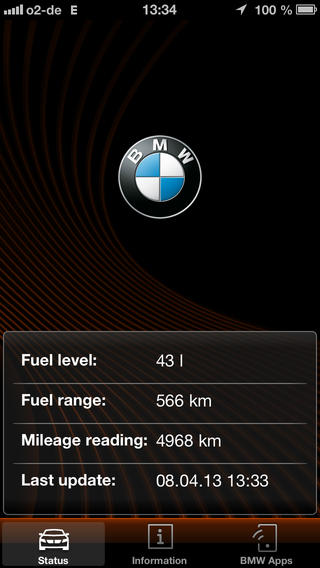

To say that they disappointed us is to say nothing. We could not post a single tweet from the car, we could not view the Facebook tape and listen to the online radio. We could not even open a single site. After all, all this can be done only on the condition that the iPhone is turned on and the BMW Connected application is active. Those. You must choose - either you use the phone or the on-board system. Honestly tell you, standing in a traffic jam is difficult to make a choice not in favor of the phone, since it all works much faster.
But back to the discussion of Connected Drive, after all, a smart player and BMW Apps is not all. Much more interesting, another chip seemed to me - the Connected Drive Store. Agree, the name is promising. That is why the mobile application development department of our company decided to knock at BMW headquarters with a question - where to get the SDK for development? But it turned out that so far, unfortunately, nowhere. Application development is conducted either on its own, or by contractors, or by someone else, but for Russian developers it is not available.
I hope that in the not too distant future, BMW will open its store for third-party developers and a lot of various applications will appear in it: from those that will share your results on the racetrack on social networks to those that will read you in audio-book traffic jams. In the meantime, there are very few applications and you can only use them by connecting the iPhone, installing BMW Connected into it, and the application itself into it. In general, as I wrote in the previous chapter, we did not succeed.
However, the Connected Drive Store can be viewed from the other side. Not as an app store, but as an infrastructure that provides automotive options, as a service. We all understand that the most expensive thing in a navigator is not iron, but maps and various services. And if you still need to order a package of cards from the factory, then various useful services: traffic jams, weather and the same Internet access can be “bought” directly from the onboard menu at any time.
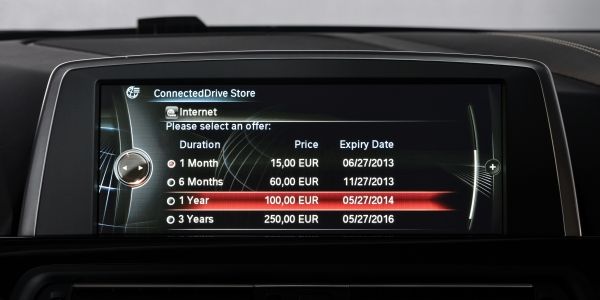
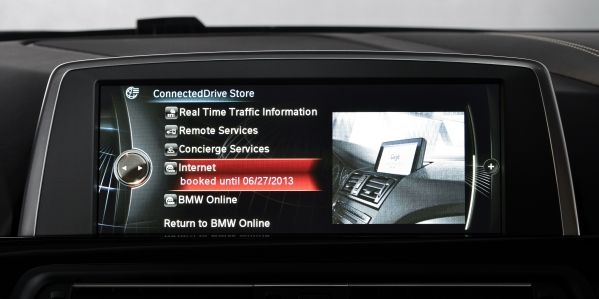
True, we could not use this functionality on the test BMW 640 either. Paid services have not reached Russia yet.
In principle, you can write for a long time about the various shortcomings of Connected Drive, about the fact that in Russia nothing is completely ready, but I’ll probably stop. For some reason, I remember how ten years ago, journalists scolded the very first iDrive, which debuted in the G7 of BMW in the back of the E65. It was the first experience of developing a unified management interface for a variety of functions among automakers. Despite all the criticism that has been addressed to iDrive, very soon we saw similar solutions from other automakers, and with each new generation iDrive itself became more and more convenient.
Surely Connected Drive waiting for a similar fate. With the only difference that, unlike its predecessor (after all, Connected Drive is a further development of iDrive ideas), everything is not limited to BMW’s technical and ergonomic tasks. But the user (I do not think it is appropriate to write a “driver”) will get really new opportunities. I do not know about you, but I already want to assemble a team and start developing applications for mobile devices with four wheels. The guys from BMW, what do you say?
... what was this picture with Yandex? It turns out that everything is very simple. This is a site interface adapted for a connected drive. You can do the same with your website right now if you think that potential users of your online service are turning the steering wheel with a blue-white propeller. Moreover, the first BMW cars with integrated Internet (not requiring all these dances with an iPhone) on board are already rolling along the roads of Moscow.
The article used photos of BMW AG

But not so long ago, the situation began to change. European manufacturers first developed their own control systems for the on-board computer and multimedia functions (Command from Mercedes-Benz, MMI from Audi, iDrive from BMW, OnCall from Volvo, etc.). Then they unified these systems throughout the model range. And then they began to "socialize" through the Internet. Of course, this will not accelerate the subsequent introduction of networks of 5-6 generations in cars or USB 4.0 and Bluetooth 5.1, when they appear. However, this will certainly reduce the gap in the software between mobile and automotive systems.
')
Connected, but not with all
In general, the idea of a test drive with Connected Drive started with what I saw on the BMW website this picture:

I once heard the story that Yandex made special Yandex cards for BMW, but it was a long time ago and at the level of rumors. And here is a screenshot of the car screen right in the description of the new 3GT model. Having seen it, I tried to find more information about what Connected Drive is and came across a large overview of its capabilities on the website motor.ru .
I confess that I did not particularly read the article. I ran over it with my eyes, saw some key facts and decided to find out whether it was possible to get a car with Connected Drive in Moscow for a test for at least a few days in order to describe my view on this system with the eyes of a person from the IT sphere. Just a few days later, I was given a BMW 640 Coupe for review and, to be honest, for the first couple of days I completely forgot about the original purpose of the test drive. Even to the careful words of an employee of the BMW Group Russia, who gave me a car, that while not everything works, that the first cars with built-in sim cards will appear in Russia towards the end of the year, that even in Germany the system is not fully deployed, I did not add attention. As a result, the very first attempt to get acquainted with the system closer turned out to be a failure. It turned out that my HTC 8X is nothing but a phone for this car. He did not even turn out to be a source of music for her via Bluetooth, which seemed quite strange.
When I found out that the music from the phone could not be listened to, I inserted a USB flash drive into the USB connector and was pleasantly surprised. Connected Drive is a rare case when the car doesn't need an iPod at all - you can listen to music by genres, albums, artists and playlists from any carrier. I lacked this chip in many car multimedia systems with USB connectors. Well, the optional sound from Bang & Olufsen is so good that you don’t want to listen to the radio on it - there’s too much of a lack of quality.
Expectations and reality
Standing in traffic jams with music is, of course, better than in silence, but with the Internet it would be even more fun. Therefore, when a colleague with an iPhone appeared on the passenger seat, we began to deal with the Connected Drive further. The phone was connected via Bluetooth and, unlike Windows Phone, it became available as an audio source. Already better, but the Internet is still unavailable. After several unsuccessful attempts to use a browser or download an application, we came across a system prompt stating that for full use we need to connect the phone via wire, and not via the wireless interface.
Okay, they pulled out a USB flash drive with music, plugged a cable into the USB connector, but that was not enough. To make it work you need to install a special BMW Connected application. It weighs more than 20 megabytes, so with the Moscow mobile Internet it is better to do it at home with Wi-Fi, rather than standing in traffic. Waiting for the installation, we finally saw the BMW Apps in work.


To say that they disappointed us is to say nothing. We could not post a single tweet from the car, we could not view the Facebook tape and listen to the online radio. We could not even open a single site. After all, all this can be done only on the condition that the iPhone is turned on and the BMW Connected application is active. Those. You must choose - either you use the phone or the on-board system. Honestly tell you, standing in a traffic jam is difficult to make a choice not in favor of the phone, since it all works much faster.
Options as a service
But back to the discussion of Connected Drive, after all, a smart player and BMW Apps is not all. Much more interesting, another chip seemed to me - the Connected Drive Store. Agree, the name is promising. That is why the mobile application development department of our company decided to knock at BMW headquarters with a question - where to get the SDK for development? But it turned out that so far, unfortunately, nowhere. Application development is conducted either on its own, or by contractors, or by someone else, but for Russian developers it is not available.
I hope that in the not too distant future, BMW will open its store for third-party developers and a lot of various applications will appear in it: from those that will share your results on the racetrack on social networks to those that will read you in audio-book traffic jams. In the meantime, there are very few applications and you can only use them by connecting the iPhone, installing BMW Connected into it, and the application itself into it. In general, as I wrote in the previous chapter, we did not succeed.
However, the Connected Drive Store can be viewed from the other side. Not as an app store, but as an infrastructure that provides automotive options, as a service. We all understand that the most expensive thing in a navigator is not iron, but maps and various services. And if you still need to order a package of cards from the factory, then various useful services: traffic jams, weather and the same Internet access can be “bought” directly from the onboard menu at any time.


True, we could not use this functionality on the test BMW 640 either. Paid services have not reached Russia yet.
The difficulties of the pioneers
In principle, you can write for a long time about the various shortcomings of Connected Drive, about the fact that in Russia nothing is completely ready, but I’ll probably stop. For some reason, I remember how ten years ago, journalists scolded the very first iDrive, which debuted in the G7 of BMW in the back of the E65. It was the first experience of developing a unified management interface for a variety of functions among automakers. Despite all the criticism that has been addressed to iDrive, very soon we saw similar solutions from other automakers, and with each new generation iDrive itself became more and more convenient.
Surely Connected Drive waiting for a similar fate. With the only difference that, unlike its predecessor (after all, Connected Drive is a further development of iDrive ideas), everything is not limited to BMW’s technical and ergonomic tasks. But the user (I do not think it is appropriate to write a “driver”) will get really new opportunities. I do not know about you, but I already want to assemble a team and start developing applications for mobile devices with four wheels. The guys from BMW, what do you say?
And still...
... what was this picture with Yandex? It turns out that everything is very simple. This is a site interface adapted for a connected drive. You can do the same with your website right now if you think that potential users of your online service are turning the steering wheel with a blue-white propeller. Moreover, the first BMW cars with integrated Internet (not requiring all these dances with an iPhone) on board are already rolling along the roads of Moscow.
The article used photos of BMW AG
Source: https://habr.com/ru/post/195228/
All Articles